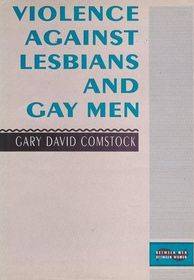Violence Against Lesbians And Gay Men
Gary David Comstock
Metropolitan Police has finally agreed, under pressure from lesbian and gay community groups, to set up a pilot project monitoring anti-gay violence, while Parliament, far from showing concern to protect this particularly vulnerable group, has recently passed actively discriminatory legislation. Comstock insists on sociological rather than a psychological analysis of ‘gay bashing’, refusing to fall into the trap, all too common in the US of simply replacing one discredited pathological label, ‘homosexuality’, with another, ‘homophobia’. He points out that, ‘Because the data show that perpetrators are predominantly average young men whose behaviour is socially sanctioned rather than intrapsychically determined, they lend themselves to a search for sociological rather than psychological explanations’ (p. 2), and this he proceeds to do. The strength of the book lies in Comstock’s demonstration of the role played by institutional heterosexism in violent attacks on individual lesbians and gay men. Using data drawn from news- paper reports, surveys of victims (including his own survey), police records and interviews with perpetrators, he dispels the comfortable myth that those who attack lesbians and gay men do so from unusually intense personal feelings of disgust or disapproval.
Although moral disapproval is common in those who restrict themselves to verbal abuse (39% of reported incidents of verbal abuse involve reference to God, religion or the Bible), Comstock’s research indicates that ‘for some teenage males attacking lesbians and gay men is not an expression of hatred and disapproval as much as it is a recreational option’ (p. 76). That violence, often resulting in severe injury or death to the victim, can be interpreted as ‘recreational’ is made possible by the marginal social position of lesbians and gay men. Put simply, young lads looking for kicks are well aware that attacking ‘queers’ is socially acceptable, indeed, almost a rite of passage into adult male status.
In a chilling conclusion, Comstock argues that, ‘unlike most juvenile offenders, who commit crimes as a means of rebelling against society, gay-bashers commit theirs as a way of being accepted by it’ (p. 92, emphasis in original). This key insight, coupled with a wealth of data, make this a timely and useful book for anyone interested in minority rights, homophobia, the welfare of lesbians and gay men, or the sociology of violence. It is also potentially of use to those interested in the social construction of masculinity, especially for adolescent males. However, Comstock lacks a theoretical perspective which would enable him to make full use of his own discoveries. Drawing on Sheila Collins’ model of patriarchal capitalism, which sees capitalist relations of power as wholly analogous to patriarchal familial relations of power, Comstock creates a familiar scenario whereby adolescent male violence against ‘lower status’ males is interpreted as an intrinsic part of the power-struggles of the masculine hierarchy. There is no critique of this process, rather, we are left with the unsatisfactory assumption that such behaviour is somehow ‘natural’ to the species ‘homo capitalists’.
Additionally, Comstock’s theological background (he is University Protestant Chaplain and Visiting Assistant Professor of Religion at Weslyan University) leads him to a scriptural, rather than political, solution to the social problem he has so clearly identified. While his analysis of the political context of Leviticus is genuinely interesting, and of very real practical use to those challenging the anti-gay rhetoric of Judaeo-Christian fundamentalism, his call for lesbians and gay men to transform their ‘pain, suffering and death’ and to share the ‘Exodus event’ with church communities is a narrowly limited response to the widespread and shocking antagonism he has revealed. While affirmative action on the part of the lesbian and gay com- munity, in the best liberal tradition, is clearly necessary (and clearly happening), there is a pressing need for a more fundamental, radical critique of what could best be described as ‘compulsory masculinity’. The book is, despite its theoretical failures, well worth reading, both as an exposé of the under- researched, under-theorised phenomenon of violence against lesbians and gay men, and for its long overdue recognition of the social sanction accorded such violence. ~ Tamsin Wilton, Sociology, Vol. 26, No. 3 (August 1992)
Check for it on:
Details
| ISBN | 9780231073301 |
| Genre | LGBT Studies/Social Sciences |
| Copyright Date | 1991 |
| Publication Date | 04-Feb-91 |
| Publisher | Columbia University Press |
| Format | Hardcover |
| No. of Pages | 319 |
| Language | English |
| Rating | NotRated |
| Subject | Gays; Gays – Violence Against – United States; Hate Crimes |
| BookID | 14075 |

